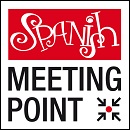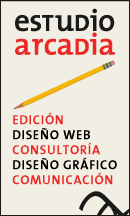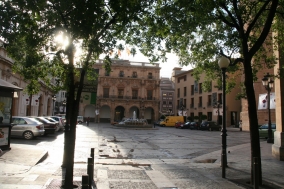Spanish schools and accommodation to study Spanish in Spain
Recent posts
Last schools
introduced
introduced
0 Accommodation

1 Spanish schools

Learning Spanish in Castellon. The tourist guide to study your Spanish course.
Taste the Mediterranean diet in Castellon by trying paella dishes and oranges. If you decide to take your Spanish lessons here, you will also enjoy Mediterranean beaches and weather!
General Information. 180,000 inhabitants. 423 kilometres to the east of Madrid. Castellon belongs to the Autonomous Community of Valencia. The city's full name, Castellón de la Plana, means ‘small castle on the plain'. It is a Mediterranean coastal city which combines the activities of a port with industry and tourism. Castellon also has fertile soil which is ideal for growing orange trees, which predominate throughout the area. Castellon has been designated by the Regional Government to develop the complex known as the ‘City of Languages' (Ciudad de las Lenguas), with the aim of promoting language tourism. The city's university is called Universidad Jaime I; it caters for 10,000 students and offers 28 different degree subjects. Spanish and Valencian are the two official languages in the city. Castellon is a very attractive place to study Spanish with many language schools offering a wide range of courses.
Surrounding Areas. Burriana (12 kilometres), which is the home of the Gothic ‘Church of the Saviour' (Iglesia de El Salvador); Benicásim (15 kilometres) and its beaches; Oropesa (23 kilometres), with beaches and a medieval old quarter; Onda (24 kilometres), awarded Historic-Artistic Grouping status in 1967; Sagunto (53 kilometres), with important archaeological Roman remains; Peñíscola (75 kilometres), a coastal town with an old quarter replete with monuments and a Templar castle; Morella (105 kilometres), a charming historical town with numerous medieval monuments. The city of Valencia is 75 kilometres away.
Main Sights. The Co-Cathedral of St. Mary (Concatedral de Santa María), also known as the Church of St. Mary Major (Iglesia de Santa María la Mayor). La Basílica de la Virgen del Lledó, a basilica surrounded by orchards. The Episcopal Palace. The Town Hall (Ayuntamiento), built in a Tuscan style. El Fadrí, a Gothic church with bell tower built between 1591 and 1604. The Post Office Building (Edificio de Correos y Telégrafos, 1932). Lonja del Cáñamo, a baroque building dating back to the 18th century. Independence Square (Plaza de la Independencia), also known as the ‘Street Light' (La Farola). The remains of the Carlist town walls. The Central Market (Mercado Central). Parks and gardens include: Parque Ribalta, Parque Rafalafena, the Royo Gómez Geological Gardens (Parque Geólogo Royo Gómez), the Auditorium garden and Parque del Meridiano, which is crossed by the Greenwich Meridian and the 40th parallel.
Culture. The Benicásim International Festival (Festival Internacional de Benicásim) in the middle of July is one of the most important open-air music festivals in Spain; every year it attracts over 120,000 young people from home and abroad, who take advantage of the music, the beach, the sun and a range of other activities. The town of Benicásim is 15 kilometres from the centre of Castellon. There are other festivals, such as Indyrock (the end of July), the Tanned Tin Festival (last week in January) and Arenal Sound (the end of July). Castellon also has the Fine Arts Museum (Museo de Bellas Artes), the Contemporary Art Centre (Centro de Arte Contemporáneo), the Municipal Ethnological Museum (Museo Etnológico Municipal) and the Aula Militar de Castellón, a cultural association. Other theatres and places of cultural interest include the Teatro Principal, built in 1894, the Teatro del Raval, and the Auditorio y Palacio de Congresos, which is used for concerts, conferences and exhibitions.
Beaches. Castellon has10 kilometres of coastline situated in Grao, the city's seaside resort, which is 4 kilometres from the centre. The three busiest beaches are: Playa de El Pinar, with its paths leading through artificial dunes, Playa del Gurugú, where you will find a great number of beach bars along the promenade, and Playa del Serradal, which is famous for the sports that are played there. The beaches are a major attraction for the many students who decide to study Spanish in Castellon.
Shopping. The city's old quarter has a wide range of shops; specifically, in Calle de Enmedio you will find the well-known brands Zara and Mango. Other fashion stores are located in Calle Cervantes and Avenida Rey don Jaime. There is also a shopping centre in Castellon called La Salera.
Gastronomy. Calle Isaac Peral, next to Plaza de Santa Clara, is recommended when going out for tapas (small snacks which traditionally accompany drinks when bar-hopping). The typical dishes of the area are based on rice, fish and shellfish and it is worth highlighting paella valenciana (a combination of rice and vegetables with rabbit or chicken), arroz abanda (rice cooked in fish stock) and arroz caldoso (a rice stew).
Sports. The city of Villarreal is only 10 kilometres away, with its famous first division football club, Villarreal CF, who play at the Madrigal stadium. Castellon also has the basketball team El Club Amics del Bàsquet, who compete in the national second division, the EBA league. In Castellon you can play or learn almost any sport. Sports facilities include the important Estadio de Castalia and the sports hall Pabellón Ciutat de Castelló, and several other swimming pools, such as the one in the Estadio, the Olímpica and Emilio Fabregat in Grao. Water sports such as sailing, windsurfing and kite-surfing are popular in Castellon, as are adventure sports and golf.
Fiestas. Fiestas de la Magdalena (March); the most representative event of these fiestas is the ‘Pilgrimage of the Canes' (Romería de les Canyes), and you will also find free concerts, magnificent firework displays and firecracker barrages (mascletás). In Grao, they celebrate fiestas to commemorate St. Peter (San Pedro) in the last week of June, with bull running, concerts and other events.
Transport. The first section of Castellon's tram line was inaugurated in 2008. For intercity connections, there is the toll motorway that runs along the Mediterranean coast as well as railway lines that link the city to Valencia, Madrid and Barcelona, as you can see it is easy to get from Castellon to other Spanish cities.
Nightlife. Students who decide to study Spanish in Castellon will discover a very active nightlife. There are three main areas for going out at night in Castellon: the area in the city centre bordered by the three streets, Gobernador, Lagasca and Caballeros; the industrial estates in the north, including the area of Castalia; and in the south, Los Cipreses. In summer, the young crowd head for Grao and the beach bars.
General Information. 180,000 inhabitants. 423 kilometres to the east of Madrid. Castellon belongs to the Autonomous Community of Valencia. The city's full name, Castellón de la Plana, means ‘small castle on the plain'. It is a Mediterranean coastal city which combines the activities of a port with industry and tourism. Castellon also has fertile soil which is ideal for growing orange trees, which predominate throughout the area. Castellon has been designated by the Regional Government to develop the complex known as the ‘City of Languages' (Ciudad de las Lenguas), with the aim of promoting language tourism. The city's university is called Universidad Jaime I; it caters for 10,000 students and offers 28 different degree subjects. Spanish and Valencian are the two official languages in the city. Castellon is a very attractive place to study Spanish with many language schools offering a wide range of courses.
Surrounding Areas. Burriana (12 kilometres), which is the home of the Gothic ‘Church of the Saviour' (Iglesia de El Salvador); Benicásim (15 kilometres) and its beaches; Oropesa (23 kilometres), with beaches and a medieval old quarter; Onda (24 kilometres), awarded Historic-Artistic Grouping status in 1967; Sagunto (53 kilometres), with important archaeological Roman remains; Peñíscola (75 kilometres), a coastal town with an old quarter replete with monuments and a Templar castle; Morella (105 kilometres), a charming historical town with numerous medieval monuments. The city of Valencia is 75 kilometres away.
Main Sights. The Co-Cathedral of St. Mary (Concatedral de Santa María), also known as the Church of St. Mary Major (Iglesia de Santa María la Mayor). La Basílica de la Virgen del Lledó, a basilica surrounded by orchards. The Episcopal Palace. The Town Hall (Ayuntamiento), built in a Tuscan style. El Fadrí, a Gothic church with bell tower built between 1591 and 1604. The Post Office Building (Edificio de Correos y Telégrafos, 1932). Lonja del Cáñamo, a baroque building dating back to the 18th century. Independence Square (Plaza de la Independencia), also known as the ‘Street Light' (La Farola). The remains of the Carlist town walls. The Central Market (Mercado Central). Parks and gardens include: Parque Ribalta, Parque Rafalafena, the Royo Gómez Geological Gardens (Parque Geólogo Royo Gómez), the Auditorium garden and Parque del Meridiano, which is crossed by the Greenwich Meridian and the 40th parallel.
Culture. The Benicásim International Festival (Festival Internacional de Benicásim) in the middle of July is one of the most important open-air music festivals in Spain; every year it attracts over 120,000 young people from home and abroad, who take advantage of the music, the beach, the sun and a range of other activities. The town of Benicásim is 15 kilometres from the centre of Castellon. There are other festivals, such as Indyrock (the end of July), the Tanned Tin Festival (last week in January) and Arenal Sound (the end of July). Castellon also has the Fine Arts Museum (Museo de Bellas Artes), the Contemporary Art Centre (Centro de Arte Contemporáneo), the Municipal Ethnological Museum (Museo Etnológico Municipal) and the Aula Militar de Castellón, a cultural association. Other theatres and places of cultural interest include the Teatro Principal, built in 1894, the Teatro del Raval, and the Auditorio y Palacio de Congresos, which is used for concerts, conferences and exhibitions.
Beaches. Castellon has10 kilometres of coastline situated in Grao, the city's seaside resort, which is 4 kilometres from the centre. The three busiest beaches are: Playa de El Pinar, with its paths leading through artificial dunes, Playa del Gurugú, where you will find a great number of beach bars along the promenade, and Playa del Serradal, which is famous for the sports that are played there. The beaches are a major attraction for the many students who decide to study Spanish in Castellon.
Shopping. The city's old quarter has a wide range of shops; specifically, in Calle de Enmedio you will find the well-known brands Zara and Mango. Other fashion stores are located in Calle Cervantes and Avenida Rey don Jaime. There is also a shopping centre in Castellon called La Salera.
Gastronomy. Calle Isaac Peral, next to Plaza de Santa Clara, is recommended when going out for tapas (small snacks which traditionally accompany drinks when bar-hopping). The typical dishes of the area are based on rice, fish and shellfish and it is worth highlighting paella valenciana (a combination of rice and vegetables with rabbit or chicken), arroz abanda (rice cooked in fish stock) and arroz caldoso (a rice stew).
Sports. The city of Villarreal is only 10 kilometres away, with its famous first division football club, Villarreal CF, who play at the Madrigal stadium. Castellon also has the basketball team El Club Amics del Bàsquet, who compete in the national second division, the EBA league. In Castellon you can play or learn almost any sport. Sports facilities include the important Estadio de Castalia and the sports hall Pabellón Ciutat de Castelló, and several other swimming pools, such as the one in the Estadio, the Olímpica and Emilio Fabregat in Grao. Water sports such as sailing, windsurfing and kite-surfing are popular in Castellon, as are adventure sports and golf.
Fiestas. Fiestas de la Magdalena (March); the most representative event of these fiestas is the ‘Pilgrimage of the Canes' (Romería de les Canyes), and you will also find free concerts, magnificent firework displays and firecracker barrages (mascletás). In Grao, they celebrate fiestas to commemorate St. Peter (San Pedro) in the last week of June, with bull running, concerts and other events.
Transport. The first section of Castellon's tram line was inaugurated in 2008. For intercity connections, there is the toll motorway that runs along the Mediterranean coast as well as railway lines that link the city to Valencia, Madrid and Barcelona, as you can see it is easy to get from Castellon to other Spanish cities.
Nightlife. Students who decide to study Spanish in Castellon will discover a very active nightlife. There are three main areas for going out at night in Castellon: the area in the city centre bordered by the three streets, Gobernador, Lagasca and Caballeros; the industrial estates in the north, including the area of Castalia; and in the south, Los Cipreses. In summer, the young crowd head for Grao and the beach bars.
© TEXT: SPANISH IN TOUR.
VIDEO: Patronato de Turismo de Castellón
VIDEO: Patronato de Turismo de Castellón























